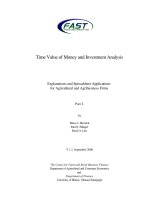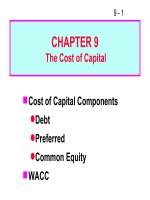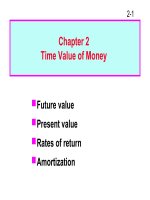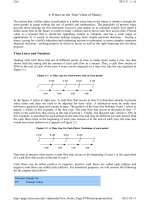Bài giảng chapter 2 time value of money
Bạn đang xem bản rút gọn của tài liệu. Xem và tải ngay bản đầy đủ của tài liệu tại đây (184.55 KB, 83 trang )
2-1
Future value
Present value
Rates of return
Amortization
Chapter 2
Time Value of Money
2-2
Time lines show timing of cash flows.
CF
0
CF
1
CF
3
CF
2
0 1 2 3
i%
Tick marks at ends of periods, so Time 0
is today; Time 1 is the end of Period 1;
or the beginning of Period 2.
2-3
Time line for a $100 lump sum due at
the end of Year 2.
100
0 1 2 Year
i%
2-4
Time line for an ordinary annuity of
$100 for 3 years.
100 100100
0 1 2 3
i%
2-5
Time line for uneven CFs: -$50 at t = 0
and $100, $75, and $50 at the end of
Years 1 through 3.
100 50 75
0 1 2 3
i%
-50
2-6
What’s the FV of an initial $100 after 3
years if i = 10%?
FV = ?
0 1 2 3
10%
Finding FVs (moving to the right
on a time line) is called compounding.
100
2-7
After 1 year:
FV
1
= PV + INT
1
= PV + PV (i)
= PV(1 + i)
= $100(1.10)
= $110.00.
After 2 years:
FV
2
= FV
1
(1+i) = PV(1 + i)(1+i)
= PV(1+i)
2
= $100(1.10)
2
= $121.00.
2-8
After 3 years:
FV
3
= FV2(1+i)=PV(1 + i)
2
(1+i)
= PV(1+i)
3
= $100(1.10)
3
= $133.10.
In general,
FV
n
= PV(1 + i)
n
.
2-9
Three Ways to Find FVs
Solve the equation with a regular
calculator.
Use a financial calculator.
Use a spreadsheet.
2-10
Financial calculator: HP10BII
Adjust display brightness: hold down
ON and push + or
Set number of decimal places to
display: Orange Shift key, then DISP
key (in orange), then desired decimal
places (e.g., 3).
To temporarily show all digits, hit
Orange Shift key, then DISP, then =
2-11
HP10BII (Continued)
To permantly show all digits, hit
ORANGE shift, then DISP, then .
(period key)
Set decimal mode: Hit ORANGE shift,
then ./, key. Note: many non-US
countries reverse the US use of
decimals and commas when writing a
number.
2-12
HP10BII: Set Time Value Parameters
To set END (for cash flows occuring at
the end of the year), hit ORANGE shift
key, then BEG/END.
To set 1 payment per period, hit 1,
then ORANGE shift key, then P/YR
2-13
Financial calculators solve this
equation:
There are 4 variables. If 3 are
known, the calculator will solve
for the 4th.
.
0
n
i1PV
n
FV =++
Financial Calculator Solution
2-14
3 10 -100 0
N I/YR PV PMT FV
133.10
Here’s the setup to find FV:
Clearing automatically sets everything
to 0, but for safety enter PMT = 0.
Set: P/YR = 1, END.
INPUTS
OUTPUT
2-15
Spreadsheet Solution
Use the FV function: see spreadsheet
in Ch 02 Mini Case.xls.
= FV(Rate, Nper, Pmt, PV)
= FV(0.10, 3, 0, -100) = 133.10
2-16
10%
What’s the PV of $100 due in 3 years if
i = 10%?
Finding PVs is discounting, and it’s
the reverse of compounding.
100
0 1 2 3
PV = ?
2-17
Solve FV
n
= PV(1 + i )
n
for PV:
( )
PV =
FV
1+ i
= FV
1
1+ i
n
n
n
n
( )
PV = $100
1
1.10
= $100 0.7513 = $75.13.
3
2-18
Financial Calculator Solution
3 10 0 100
N I/YR PV
PMT FV
-75.13
Either PV or FV must be negative. Here
PV = -75.13. Put in $75.13 today, take
out $100 after 3 years.
INPUTS
OUTPUT
2-19
Spreadsheet Solution
Use the PV function: see spreadsheet.
= PV(Rate, Nper, Pmt, FV)
= PV(0.10, 3, 0, 100) = -75.13
2-20
Finding the Time to Double
20%
2
0 1 2 ?
-1
FV = PV(1 + i)
n
$2 = $1(1 + 0.20)
n
(1.2)
n
= $2/$1 = 2
nLN(1.2) = LN(2)
n = LN(2)/LN(1.2)
n = 0.693/0.182 = 3.8.
2-21
20 -1 0 2
N I/YR PV PMT FV
3.8
INPUTS
OUTPUT
Financial Calculator
2-22
Spreadsheet Solution
Use the NPER function: see
spreadsheet.
= NPER(Rate, Pmt, PV, FV)
= NPER(0.20, 0, -1, 2) = 3.8
2-23
Finding the Interest Rate
?%
2
0 1 2 3
-1
FV = PV(1 + i)
n
$2 = $1(1 + i)
3
(2)
(1/3)
= (1 + i)
1.2599 = (1 + i)
i = 0.2599 = 25.99%.
2-24
3 -1 0 2
N I/YR PV PMT FV
25.99
INPUTS
OUTPUT
Financial Calculator
2-25
Spreadsheet Solution
Use the RATE function:
= RATE(Nper, Pmt, PV, FV)
= RATE(3, 0, -1, 2) = 0.2599









